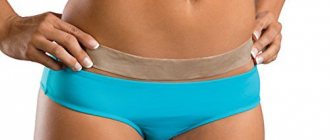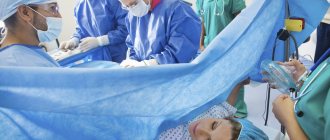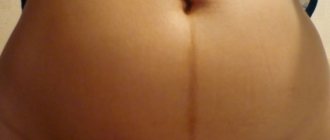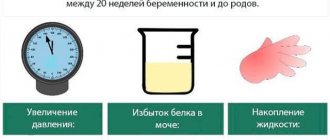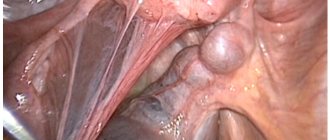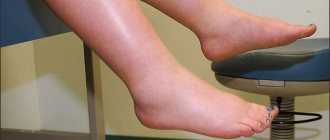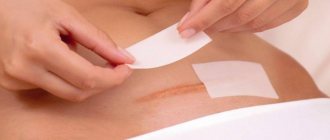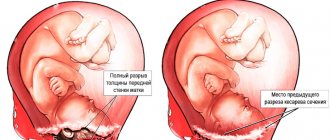Caesarean section is an abdominal operation that is used during childbirth for various reasons. Sometimes they are based on indications - there are often situations when a doctor recommends surgical obstetrics to a patient due to abnormal positioning of the fetus or other circumstances. Often, expectant mothers themselves insist on a CS, citing their fear of pain during natural childbirth.
Does your right or left side hurt?
Right left
Of course, when the newborn is removed through an incision in the uterus, the woman suffers much less pain. But we should not exclude possible consequences that threaten to arise after the operation. In addition to the long healing time of the suture, other unpleasant sensations may also occur. For example, quite often young mothers complain of pain in the right or left side. What they can be caused by and what danger they signal, we will consider further.
Condition of the abdomen after caesarean section
The operation to remove the fetus from the uterus, called a caesarean section, can be performed either urgently or planned. A planned operation is prescribed in cases where it is known in advance about the impossibility or undesirability of giving birth naturally. The doctor assesses the situation, weighs the risks and chooses the best option for delivery. The date of the planned operation is set several days before the expected date of birth, usually at 39-40 weeks of pregnancy, if the operation is the first. In case of a repeat cesarean section, it can be prescribed at the 38th week (for more details, see the article: at what stage of the second pregnancy is a cesarean section performed and how is the procedure performed?).
Despite its prevalence and apparent technical ease, the operation is very traumatic, affecting not only the skin and tissue, but also muscle tissue. With a planned caesarean section, the operation is often performed by making a horizontal incision in the skin of the lower abdomen above the pubis, then the doctor cuts the subcutaneous tissue, dissects the aponeurosis and parietal peritoneum, the wall of the lower segment of the uterus. After the baby is removed, the placenta is removed, and then surgeons apply sutures in stages: first, two rows of sutures on the uterus, then layer-by-layer on the peritoneum, and a cosmetic suture on the skin layer of the abdomen.
In case of emergency surgery, to save time, a vertical incision is made along the white line of the abdomen - lower median laparotomy. Tissue suturing is performed in the same sequence as during a planned operation. The recovery process after a horizontal incision in the lower abdomen may be a little easier than with a longitudinal incision, but pain after surgery is present in both cases.
Normal symptoms
Normally, after the birth of a child, the mother’s recovery process lasts up to 2 months. In the first days, a woman may experience acute cutting pain in the area of the postpartum suture; she may have pain on the left or right side, or other parts of the abdomen. Some mothers complain that their belly button hurts. These are normal signs of wound healing after cesarean section, which are most pronounced in the first 3-4 days after surgery, then their intensity decreases.
Causes
Specialists can determine the original source of the pathology after diagnosis and depending on which joint the pain syndrome appears in.
- Hip joint. If the birth canal of a child is obstructed, the hip joint is most often affected. During childbirth, the pelvic bones diverge very widely; recovery will take at least 2 weeks.
- Leg joints. They are affected due to the enormous burden placed on the female body. As the fetus develops, the weight of the baby and amniotic fluid increases; the ankle and knee joints suffer the most from excess body weight. When the baby is born, the load on the legs decreases, but the mother has to spend the whole day on her feet, which causes pain.
- Hands, wrist joints and fingers. Pain in this area is rare. Most often, the primary source is grabbing sheets and other objects during childbirth. After the birth of a baby, a woman has to constantly carry and rock him in her arms, which negatively affects the cartilage tissue of the hands and fingers.
If the disorders are caused by natural causes, with proper treatment, the pain syndrome goes away within a month. But if the primary source of the disease is birth injuries and complications, recovery can take up to six months.
Why do abdominal pain and numbness occur after a caesarean section?
Pain after cesarean section is caused primarily by forced damage to a large area of tissue. Neither the level of physical fitness of a woman before childbirth, nor the professionalism of the surgeon can protect against pain after major abdominal surgery.
Bloating and constipation, a painful stomach, are associated both with pressure on the intestines during childbirth, and with subsequent contractions of the uterus and its effect on the digestive organs. Abdominal numbness, which mothers often complain about after childbirth, is caused by damage to nerve endings during surgery.
How to help yourself?
In order for you to start feeling good as soon as possible, after 3-4 hours you need to start turning over in bed, bending your legs at the knee and ankle joints, bending and raising your arms, squeezing and unclenching your hands, and drawing in your stomach as you exhale.
After 10-12 hours try to get up. Wear a bandage. Do breathing exercises.
Interesting! Kegel exercises (tension and relaxation of the perineal muscles) are very good for improving blood circulation in the pelvic organs and speeding up their recovery.
How long does the stomach hurt and go numb after surgery?
How long will it take for the lower abdomen to stop hurting? The woman begins to experience pain immediately after the anesthesia wears off. As a rule, in the maternity hospital they help relieve severe pain with the help of painkillers, but sharp pain can return during careless movements, when walking, turning over on the other side in bed, coughing and laughing. As a rule, the most intense pain is observed in the first days after the operation, it gradually subsides, and a month after the cesarean section the pain goes away completely.
Discomfort caused by contractions of the uterine muscles is most severe in the first 3-4 days, then gradually decreases, but may return during breastfeeding. On average, it takes a month for the uterus to return to its previous size. Damaged nerves are the slowest to recover: a numb stomach can bother you for a very long time - up to a year or more.
What to do?
Ask your doctor. If he says there's nothing wrong, then don't worry. The swelling will go away in the next two weeks.
In the meantime:
- Do not overuse salty and spicy foods.
- If possible, raise your legs up several times a day.
- Try to rest more rather than stay upright all day.
- Foot massage. Smooth your legs from the toe to the top.
- Gymnastics. Rotate your feet, stand and walk on tiptoes, on the outside and inside of your feet, shift your body weight from your toes to your heels and back. Lying down with your leg raised, write out numbers from 1 to 20.
- Do contrasting foot baths
Swelling of the legs should decrease every day, and there should be no pain. Otherwise, contact your surgeon.
The nature and localization of pain after cesarean section
Postpartum pain of varying intensity in most cases is observed in different areas of the abdomen, but other localization of discomfort may also occur. The pain, as a rule, is concentrated in the lower abdomen - where the surgical incision was made, as well as in the area of the uterus, which is rapidly returning to its previous size.
Sources and nature of pain:
| Localization | Nature of pain | Cause |
| The seam | In the first days - pronounced, cutting, sharp when walking and other movements, may appear when sneezing, coughing, or with a strong inhalation. | Damage to a large area of tissue |
| Uterus | Drawing, similar to severe pain during menstruation | Uterine contractions |
| Back | Drawing or shooting pains, stabbing | Long-term stress on the spine during pregnancy, pinched nerves, pain after the injection of anesthetic during spinal anesthesia |
| Head | Episodic mild pain | Use of anesthesia during surgery |
| Intestines | Intense pain | Increased gas production or difficulty defecating |
| Navel | Dull, nagging pain | Umbilical hernia |
Pain when urinating after cesarean section
If you have difficulty or pain when urinating, then you can try several ways, for example, turning on the water tap, since otherwise you will have to insert a catheter. It is also worth noting that some medications used during surgery to relieve pain can have a negative effect on bladder function. Some women may experience physical injury associated with a urinary catheter. Therefore, if you experience burning pain while urinating, especially if it is repeated, you need to tell your doctor.
Causes for concern
Despite the fact that pain and other discomfort are natural during the early postpartum period, there are dangerous signs, if you notice them, you should immediately seek medical help. For example, acute and sharp pain is typical only for the first days after delivery; pain at the end of the recovery period or after its completion cannot be considered normal. Some conditions can be life-threatening for a woman, but their timely detection will help prevent a critical situation.
Dangerous symptoms:
- persistent severe pain in the suture area;
- pain in the abdomen, accompanied by general weakness;
- resumption of pain after a period of calm;
- bloody discharge from the suture;
- prolonged, very heavy vaginal discharge;
- unpleasant odor of discharge, admixtures of pus;
- constant nagging pain in the side;
- intense headaches;
- The navel hurts a lot.
Joint pain
Gaining weight while carrying a child puts a decent load on the spinal column in general and on the joints in particular. Physiological changes in hormonal levels lead to softening of joints and ligaments.
The center of gravity shifts, and the joints also shift to some extent. After childbirth, painful sensations arise due to the return of the joints to their usual position. The legs in the knee area are especially affected.
Also, the cause of joint pain can be a lack of calcium and magnesium in the body. After all, the costs of these minerals are increased due to lactation.
If joint pain is not associated with a chronic disease, and only appeared during the postpartum recovery period, you can take some measures to improve your well-being.
- Adjust your diet, trying to consume foods rich in calcium: fish, dairy products, sesame seeds, spinach, etc. If necessary, consult your doctor for a recommendation for multivitamin complexes.
- Do not lift more than the child's weight. This will reduce the load on the joints.
- Wear comfortable shoes and clothes.
- Use elastic bandages to secure the joint.
- Do special gymnastic exercises.
If the described recommendations do not help, then you should consult a rheumatologist to prescribe medication treatment.
How to alleviate a woman's condition?
To reduce discomfort in the intestinal area and eliminate bloating, it is recommended to exclude foods that cause intense gas formation from the mother’s diet. The menu should include fermented milk products and a large amount of clean water. For constipation, a massage in the form of light stroking of the abdomen in a clockwise direction is recommended to stimulate bowel function.
Severe pain in the suture area should be treated with painkillers. In the maternity hospital, after a cesarean section, a woman is given an IV with oxytocin, which promotes uterine contraction, and, if necessary, analgesics are prescribed (we recommend reading: how long does the process of uterine contraction last after a cesarean section?). To reduce pain and speed up the recovery period, it is recommended to wear a postoperative bandage that will support the abdomen, additionally secure the suture on the outside and make movement easier. It is necessary to follow all doctor's recommendations for caring for the suture.
Obstetrician-gynecologist, reproductive specialist, lactation consultant, graduated from ChSU named after. Ulyanova with a specialization in gynecology, mammology Read more »
Sources of pain
You need to carefully monitor your health
As a rule, in the first postoperative days the patient feels pronounced pain, which is not surprising, because cesarean is still an operation in which an incision is made on the woman’s peritoneum and uterine wall. Therefore, the appearance of pain after a cesarean section is a completely natural phenomenon, because a surgical operation never goes away without leaving a trace and requires a certain rehabilitation period.
A suture is placed on the uterus and abdominal wall. Usually, during a planned operation, the suture is made horizontally, and during an emergency intervention, it is made vertically. In the latter case, getting to the baby and removing him is much faster, which is why this is the incision that is performed during emergency surgical delivery.
Suture pain
When the anesthesia wears off after delivery, the woman inevitably experiences intense painful symptoms in the suture that appears at the incision site. Dense suture structures put pressure on the tissues gathered together, which is why pain occurs - a completely natural postoperative consequence. Painful symptoms in the suture structures will bother you for at least another week. You can take a drug from the category of painkillers after a cesarean section, however, women often choose pain so as not to mix milk with medications that are not at all beneficial for the baby.
After about a week, the unpleasant painful symptoms in the suture tissues will begin to decrease, but the pain will still clearly manifest itself when the abdomen tenses during laughter, coughing, sudden movements, etc. Painful sensations can radiate to the side, left or right side. Such signs indicate that it is too early for mommy to return to her usual household chores, so exercise is still prohibited. Rest more, do less housework. Now a mother should have only one concern - the newborn baby. It takes about 3-4 months for a woman to fully recover, during which the pain will decrease in severity every day.
I have a stomachache
Painful discomfort in a woman's abdomen is often confused with contractile uterine activity, during which the uterus returns to its previous size. In addition, in the postoperative period, painful discomfort in the uterus is often caused by the presence of a fresh scar that appeared during surgical delivery.
- The presence of a wound and contractile uterine activity cause very unpleasant painful sensations that any woman can easily endure.
- The most pronounced pain, as noted by the mothers themselves, worries patients in the first 3-5 days after surgery. The uterus is simply contracting intensely.
- Pain in the uterus may occur when breastfeeding
Contractile activity is especially enhanced during feeding, which is associated with stimulation of the nipples, which promotes uterine contractions.
- To speed up uterine recovery and return to original parameters, patients are advised to take oxytocin-containing drugs like Dinoprost or Demoxytocin, Hyfotocin or Ergotal. These drugs are taken in a short course until the uterus is completely restored to its pre-conception state.
Such medical assistance promotes rapid restoration of the uterine body and helps facilitate the process of independent restoration of a woman’s main reproductive organ.
Back pain
The gestation period is a whole test for the mother's body. After all, the load on the vertebral structures increases significantly, which is fraught with various spasms, pain and nerve pinching. It is as a result of pinched nerves that characteristic pain in the back most often occurs. After surgical delivery, they can be phantom in nature; simply, over the months of gestation, the patient’s body gets used to the pain.
Quite often, mothers complain of the appearance of acute painful sensations in the lumbar region after a cesarean section. Most often, such pains bother mothers who gave birth naturally, but they also occur in cesarean patients, especially in those whose labor began traditionally, but then difficulties arose and the mother had to be cesareaned. In such a situation, lumbar pain is a consequence of muscle sprains during pushing, because the fetus is large to pass through the birth canal, so sprains in such situations are inevitable, as is the pain they cause.
One of the important factors is the state of the vertebral structures before conception. If the patient had any curvature or poor posture, then she is more likely to experience lumbar pain. Pain may also occur in the lower extremities. In this case, experts say that postpartum swelling has not yet passed or the processes of varicose veins are beginning. Therefore, women are recommended to wear special compression stockings for caesarean sections.
Intestinal discomfort
It’s worth taking a break from certain foods for a while.
Also, painful symptoms after cesarean section can be caused by intestinal problems, because surgical measures cannot but affect the activity of the gastrointestinal tract. Especially often, women after childbirth by cesarean experience excessive gas formation, which can cause quite severe abdominal pain. To relieve such pain, it is necessary to restore intestinal motility, which will help significantly alleviate the patient’s condition.
But do not self-medicate, since only a specialist can select the appropriate medications. It is also recommended to create a suitable diet, refusing to eat cabbage and legumes, kefir and milk, grapes and cheese, biscuits, buns, soda, etc.
Intestinal problems sometimes interfere with bowel movements, and postpartum constipation aggravates the situation. In such a case, there is no way to do without the help of a specialist. Usually, in order to reduce discomfort and painful symptoms, it is enough to normalize the functioning of the gastrointestinal tract, for which patients are prescribed rectal suppositories that soften stool, suppress the formation of gases and stimulate intestinal peristalsis. An excellent prevention of such problems is physical activity. After surgery, a woman needs to start getting up as early as possible and walking more.
If the source of pain is a scar
When the suture connecting the edges of the surgical wound heals, a dense scar formation is formed, which in itself brings the patient a lot of discomfort, manifested by painful sensations and tingling.
- For health, such sensations cannot in any way be dangerous, but still they are associated with certain inconveniences for mommy.
- In the first couple of weeks, the patient needs to carefully monitor the condition of the suture tissue and listen sensitively to the sensations inside the seam.
- Make sure that the wound is always clean; even a small drop of purulent mass is unacceptable, because it may indicate contamination of the suture and the penetration of infection into it.
- If the patient suddenly develops a fever, the temperature rises and her health begins to deteriorate sharply, it is necessary to immediately inform the treating specialist.
